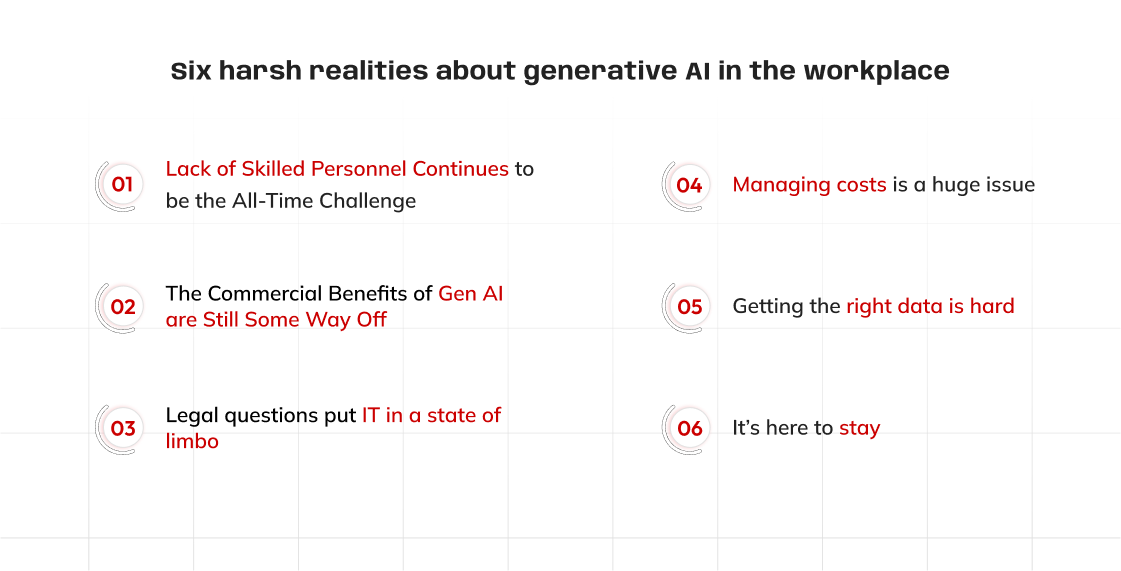From challenges in finding skilled labour to issues of getting the data equation right, IT leaders are discovering the intricacies of genAI the hard way: in real time.
With the rapid rise in the use of generative AI, the technology is bringing with it a range of reactions within organizations – from excitement and optimism to anxiety and worries.
According to a May global survey conducted by McKinsey, the proportion of organizations that have embraced generative AI stands at 65 per cent, almost twice as many as the firm’s previous survey conducted ten months ago. And with that growth, the use cases have also increased in number.
As with any past technology adoption paradigm, Jim Rowan, a principal at Deloitte Consulting, says that most of them are now beginning to embrace genAI in business domains that are of tactical advantages such as enhancing the current processes and cutting costs. This helps in extracting value from the ‘low-hanging fruit’ while gaining knowledge, skills, and trust with the new technology – this is how Rowan puts it.
Still, the levels of genAI use differ greatly from one organization to another. For instance, in some organizations, the early adopters are now moving pilots to production by connecting multiple use cases and demonstrating efficiency gains. In other cases, fluency has been attained and some proofs-of-concept attempted, with a large focus on off-the-shelf AI technologies, Rowan explains. The last sect opted for the more conservative wait-and-see paradigm.
As organizations are trying to understand how to move from internalizing concepts of generative AI to first trying out small pilots and then implementing that can revolutionize their enterprises, these are six hard truths IT leaders have been able to obtain easily by assimilating them.

1. Lack of Skilled Personnel Continues to be the All-Time Challenge
34% of respondents who displayed a strong understanding of the implications of incorporating AI technologies within their organizations viewed improvement.
Nonetheless, they also experience more strain in integrating the new technology as they view genAI more as a liability or a threat to their existing business.
“This tells us that even organizations that believe that they are geared up for new AI applications are bracing themselves for headwinds,” says Rowan.
As a consequence, IT leaders, even those who rate the level of AI knowledge among their members as high, are contemplating AI-based talent models that are anchored on reskilling, which was necessary to address AI skills deficit.
2. The Commercial Benefits of GenAI are Still Some Way Off
In his remarks on the realities of GenAI, Aamer Baig, a senior partner and global genAI practice leader at McKinsey, implied that there are probably very few genAI projects making a bottom-line impact.
Fifteen per cent is how many companies had, at least, a line of sight into earning would-be improvements as explained regarding the companies surveyed by McKinsey. “Not all use cases are equal. Not many bring value.” He proposed that the companies shift their attention to “those that are well-defined business problems, which can be solved using technology and have low risk.”
Another finding from the report prepared by Deloitte revealed that 48% of the organizations do not look forward to seeing the transformation from generative artificial intelligence in the range of one to three years.
UK-based CNH, according to Marc Kermisch who is the global chief digital and information officer, was one of the first companies to use Microsoft Copilot and in November 2023 the company started building original large language models.
Kermisch goes on: “We definitively have learned how there are many constraints,” and he continues that “it is not the magic bullet that we all envisioned it would be.”
A few productivity improvements have taken place, but Kermisch imagined that the improvements would come even more in such activities as invoice treatment. “GenAI is, for the most part, what I’m going to define as an information synthesis tool,” Kermisch states. He states that off-the-shelf genAI tools have “not worked for any finance or number crunching analysis for that matter.”
Another concern is the multitude of tools and technologies available, which Baig mentioned should be controlled. “One of the key barriers to scaling up on Generative AI today is the numerous genAI tools,’’ he expressed.
‘’Every week comes another fantastic piece of software with striking capabilities and possible future uses,’’ agrees David Higginson, chief innovation officer and executive vice president of Phoenix Children’s Hospital. However, right now, genAI “could only be commercialized by a handful of technology players, rather than being played around with within the confines of a healthcare organization’s internal innovations group,” he explains. “As a result, I feel that we are in somewhat of a limbo period, waiting for the incumbents to offer products that are created already, which are the ones that will give the benefits that we were all expecting.”
Higginson assures that appropriate solutions will come up to address real challenges faced by healthcare providers. When that occurs, it “will require individuals to make difficult choices concerning acceptable levels of risk, costs, satisfaction of providers and clinical results,” he adds.
3. Legal questions put IT in a state of limbo
Yet, even as interests will seek to exploit the opportunities that AI presents, there will be controls in the way parameters towards such activities will be defined and sparsely exercised.’’ Dunn continues, “In both instances, the potential upside and the potential downside of the technology are considerable.”
Rowan replies, “National entities, as well as legal policies, will be able to enhance the benefits of generative AI and curb the exuberance of its use without stifling creativity and advantage to few. But there is still a caveat. There exist extreme polarities of thoughts about the social, economic and cultural effects of the technology.”
Rowan takes note of the reservations some of the research respondents had about the possibilities of a positive economic impact from generative AI. More than half of the study respondents expressed the belief that increased generative AI adoption will concentrate power in the world economy (52%) and worsen economic disparity (51%).
Restructuring of how capital flows and who controls investment decision processes will also happen as enhanced use of generative AI is anticipated shortly. As observable, more than half of the KAP survey participants fear that the excessing incorporation of generative AI will limit the power dynamics in the global economy to the few rich and their systems (52%) and aggravate economic disparity (51%).”
In recent decades, thoughtful creators have helped lucid narrative and innovational strategies that have fostered societal concepts, norms, and practices. Many such innovations have been supported within countries or regions. They have not sufficiently developed transnationally. But also, there are polar extremes of opinions regarding the social, economic and cultural impact of the technology.
4. Managing costs is a huge issue
In a similar line to Higginson, who stated that the high cost of implementing genAI was an issue, Baig from McKinsey noted that organizations need to be able to control costs- lest they lose control and be managed by the costs. This is attributable to the high compute intensity and high change management which sit at the core of genAI.
He suggested that organizations allocate assets to these recommendations with the same degree of emphasis as one would turn to achieve digital transformation because these workflows and business processes as well as new KPIs would evolve with genAI. Also, there has to be risk and hallucination training built into the system, and made necessary ongoing expenditure on maintenance, said Baig.
Noting that genAI suffered from scarcity and cost of hardware, power, as well as data needed to train models – which were the primary issues cutting its adoption, Higginson observes. “Given that such resources are limited, there is a logic to stratifying solutions based on who maximally benefits from them and which has the greatest potential revenue return,’’ he adds.
Kermisch from CNH also stated that genAI “could help us bend our cost curves,” but very little has changed. It costs a lot of money to set up the platforms and the more the genAI is used, the more the costs increase, he explains.
“If I could gain the investment back in productivity, great, but it’s not translating one for one,’’ he explains. This might pose a problem considering that the company has few licenses for the Copilot app which the IT department circulates among the employees who usually love engaging with new technology.
This usually tends to die down. “Generally, that lasts for about 30 days, after which usage levels decline sharply,” explains Kermisch. “There is the [phenomenon of] the shiny new tool. They’ll open up an Excel spreadsheet and try to use Copilot and realize quickly they can’t use it.”
It works, he said, if the right prompt is given. “Provides ample results if you prompt correctly.” Still, “We haven’t found that power user yet.”
“Advancement in AI technology is exceedingly rapid, therefore we are striving to remain adaptive and are implementing it gradually to observe its effectiveness,’’. ‘We are evaluating the costs and the rate of [adoption] yet not erecting so many barriers that we become obsolete’.”
5. Getting the right data is hard
As of now, numerous corporations have the problem of using appropriate quality data, since genAI models are data-hungry and demand a lot of relevant data to execute correctly.
According to Baig of McKinsey: ‘Organizations should not waste time and resources on the search of perfect data. It is a huge, daunting challenge. Many opt to do a top-down approach towards data management, and that ends up looking like a massive spreadsheet.’, he explained. “Look for data that are relevant to many different use cases.”
Regulatory and commercial barriers continue to advance on the capabilities of www.gen-ai.com, ‘we know that data is a key component to delivering A.I. capabilities and we also appreciate that a lot of enterprises are realizing the heavy legwork needed to establish proper data architectures to support large scale A.I. implementations,’’ states Rowan of Deloitte.
According to CNH’s Kermisch, they have discovered that building large language models (LLMs) based on text or documentation is “fairly high in value and relatively quick turnaround.”
Eventually, he explains, the executives at CNH are convinced that genAI will enhance their operations positively although the time is still too early. “We expected that we would in a few months see great enhancements in our capacity to make vehicle designs and efficiencies by carrying out tasks robotically, which has not happened. Kermisch states: ‘Combining the two has not happened. There are positive outputs and positive outcomes but using limited cases only.”
6. It’s here to stay
Even though there are challenges encountered in the process, genAI is here to stay according to the IT leaders.
Higginson of Phoenix Hospital mentions that I am sure there will be both spectacular successes and failures during which the industry transforms within the next five to ten years.
“It requires a strategy and roadmap to be implemented properly for it to have a positive impact on your business, to be able to enhance your capabilities, and reach your business goals,’’ Corrigan avers.
That in turn calls for organizations to develop use cases and the tools they want to employ as there are elements of shadow genAI creeping in.
‘’The unfortunate reality is that even when a particular AI tool has not been deployed by a company, employees are utilizing ChatGPT and other third-party AI tools because of their increased efficiency,” states Olsson from Briggs & Stratton. “The hard truth is, if you don’t start giving them tools, they’re going to find them; even if they’re not doing anything with AI, the data risk is there. It’s a new information security risk.”
This was also echoed by Dave Pawlak, executive director of IT at Consumers Energy, who stated that while genAI can be useful, its adoption must be done securely, “and it’s not as easy as what the public is experiencing with OpenAI or other [open] generative AI tools.”
And yet, there is also a growing sentiment among Kermisch, Pawlak, Baig et al., able to justify swiftly, safely, and at scale the genAI that is worth.
“It will allow you to go from pilot to scale,’’ Baig said. “Unlike other digital disruptions, I believe we’re in a phase of genAI where a level of investment is needed,” as well as a better understanding of the technology.
Frequently Asked Questions (FAQs)
1. What are the biggest challenges with implementing generative AI in the workplace?
The six major challenges include: skills shortage among employees, delayed return on investment, legal and regulatory uncertainties, high implementation and maintenance costs, difficulty acquiring quality training data, and managing the proliferation of AI tools across the organization.
2. How long does it take to see benefits from generative AI implementation?
According to recent surveys, 48% of organizations don’t expect to see significant transformation from generative AI within 1-3 years. Only 15% of companies currently have a clear line of sight to measurable improvements, indicating that benefits are typically delayed rather than immediate.
3. Why is there a skills shortage in generative AI adoption?
Even organizations with high AI knowledge ratings struggle with implementation. The rapid evolution of AI technology creates a constant need for reskilling and upskilling employees. Many companies are developing AI-based talent models focused on continuous learning to address this skills deficit.
4. What makes generative AI implementation so expensive for businesses?
High costs stem from several factors: compute-intensive infrastructure requirements, expensive hardware and power consumption, ongoing maintenance expenses, change management costs, and the need for specialized training. Many organizations find that costs continue to increase with usage without proportional productivity gains.
5. How can companies manage data requirements for generative AI projects?
Organizations should focus on finding data relevant to multiple use cases rather than seeking perfect datasets. Building large language models based on text and documentation often provides higher value with quicker turnaround. Companies need robust data architectures to support large-scale AI implementations effectively.















